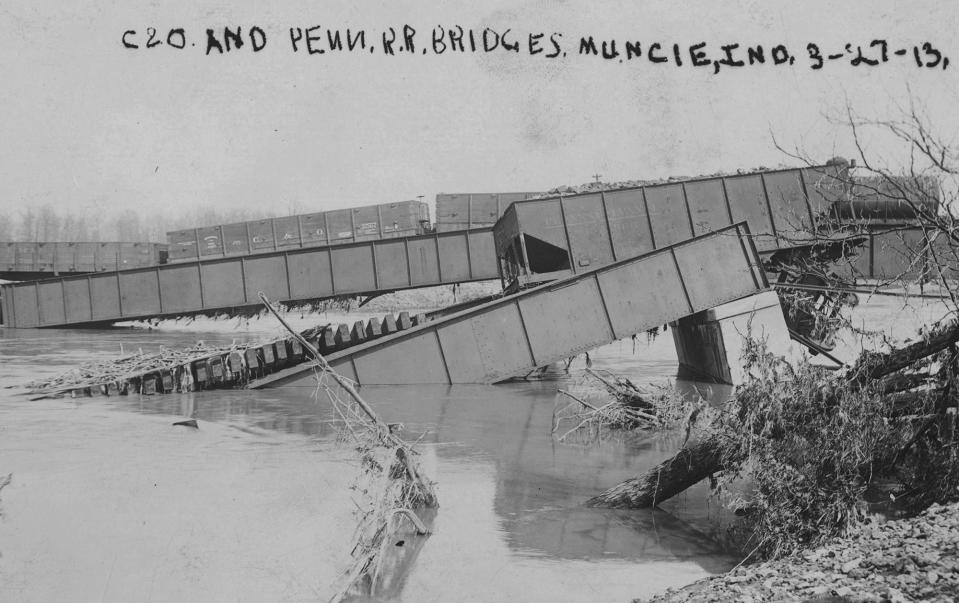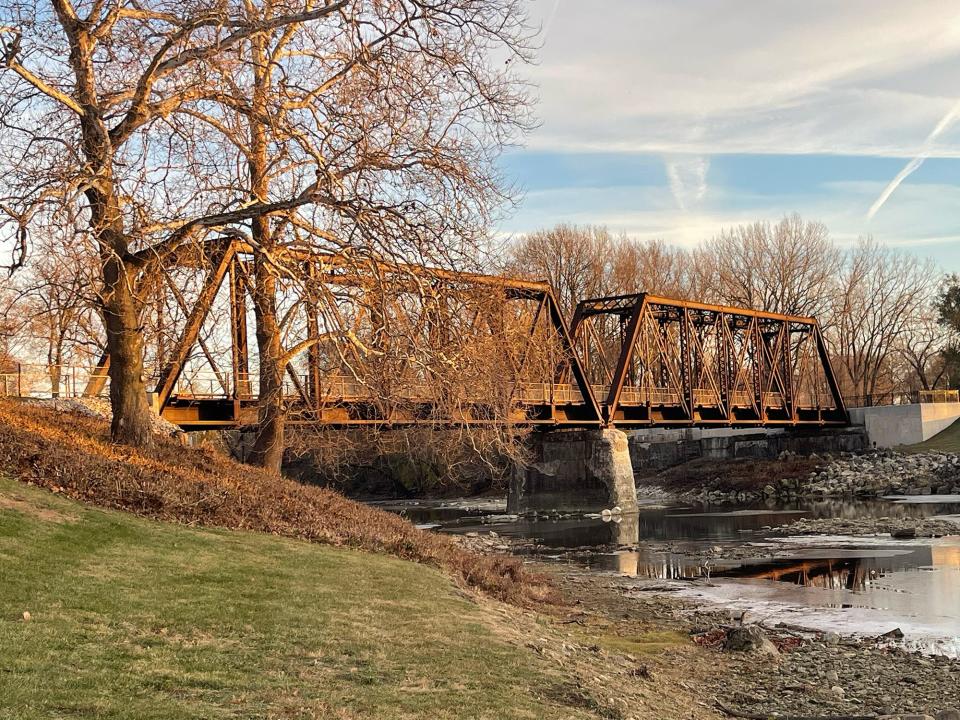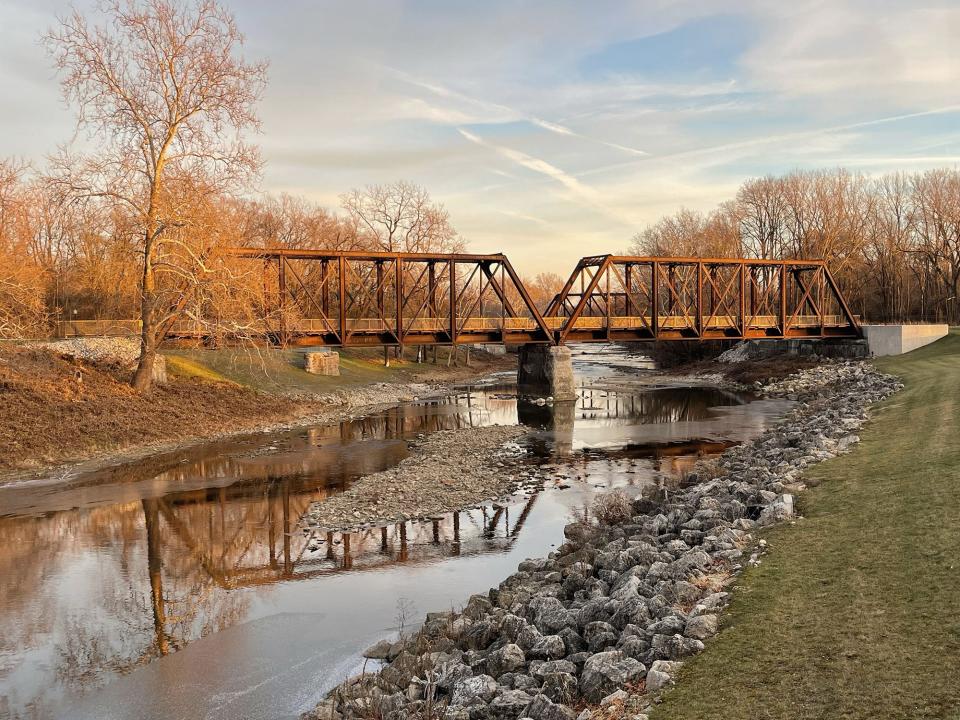ByGone Muncie: The magnificent return of Pennsy Bridge
MUNCIE, Ind. – A few weeks ago, the Cardinal Greenways and Muncie Sanitary District opened the rehabilitated Pennsylvania Railroad bridge at McCulloch Trailhead. The span was restored this year to transport the Greenway over the White River. The old Chesapeake and Ohio Railway bridge to the east had carried the trail across for decades, but was dismantled this summer due to safety and river flow concerns.

The beautifully restored seven-panel Platt Truss "Pennsy Bridge" was built at the behest of Pennsylvania Railroad in spring 1916. It replaced an earlier bridge from 1900 that had failed during the Great Flood of 1913.
When the Pennsy Bridge was erected just before World War 1, it marked the end of major railroad building in Delaware County. Many residents here had advocated for rail in the 19th and early 20th centuries. Farmers wanted rapid access to regional markets, while travelers looked to rail for speed and efficiency. Industrialists sought railroads as reliable and cheap options for bulk shipping. During the Indiana Gas and Oil Boom of 1886-1910, railroads accelerated the growth of the county’s manufacturing base and better connected Muncie to the world.
The first to arrive was the Indianapolis & Bellefontaine in 1852. The Lafayette, Muncie & Bloomington and the Fort Wayne, Muncie & Cincinnati railroads followed in the 1870s. Later in 1899, the Central Indiana Railroad was built to haul coal into Muncie as natural gas pressure waned. The Muncie Belt Railway opened in 1894 and Muncie & Western in 1902. Both connected southside factories to inter-city railroads. In the early 20th century, electric Interurban lines connected Muncie to Hartford City, Portland, Winchester, New Castle, and Anderson.

Yet by the turn of the century, there was a gap in rail service on the county’s northwest side toward Marion and southeast in the direction of Richmond. Industrialists in Muncie allied with counterparts across East Central Indiana to advocate for a direct rail corridor between Cincinnati and Chicago, by way of Richmond, Muncie, Marion, Peru or Logansport, North Judson and Hammond.
Two railroad companies competed to establish the route through Muncie in 1900: the Cincinnati, Richmond & Muncie Railroad and the Chicago, Indiana & Eastern Railway. Both railroads lobbied the region’s communities for financial support and received subsidies from Delaware and Wayne counties to begin construction.
The C.I.&E. and C.R.&M. proposed to build their railroads between Muncie and Richmond basically along the same route, what is today’s Cardinal Greenways corridor. C.I.&E. was better positioned to begin work, having already completed a line from Converse to Matthews in the late 1890s. At Converse, C.I.&E. linked to Pennsylvania Railroad’s busy Panhandle Route, which ran between Pittsburgh, Columbus, and Chicago.
C.I.&E. Railway reached Muncie in late 1900 from the north. On November 23, the Muncie Morning Star reported that “the work on the new bridge for the Chicago, Indiana, and Eastern Railway, across White River, is progressing slowly but surely. The south abutment has been completed and the one pier put in.” The Indiana Bridge Company of Muncie was awarded the contract. Trains began running daily at the end of the year, crossing the bridge to arrive at C.I.&E.’s new Wysor Street Station along North Madison.
C.I.&E. Railway struggled financially after reaching Muncie. Although they eventually extended a line to Ball Brothers Glass Manufacturing, they never completed the route into Richmond. The company went bankrupt in 1907 and was taken over by the Pennsylvania Railroad. Thereafter, the service was known as the Pennsy or the Chicago Short Line. At its height during the First World War, eight trains ran daily between Muncie and Converse.

Competitors at C.R.&M. Railroad made it to Muncie in 1901 from the south. They opened the beautiful Wysor Street Depot in summer, which today serves as headquarters for Cardinal Greenways. The original C.R.&M. bridge over the river was completed the same year by the Wabash Bridge Company. The line was extended to North Judson in 1902. Eight years later, C.R.&M. became part of the Chesapeake and Ohio Railway, connecting Cincinnati to Chicago by way of Richmond, Muncie, Marion, Peru, and Hammond. The track was abandoned in the 1980s and became the greenway a decade later.
The original Pennsy and Chesapeake & Ohio bridges failed spectacularly during the Great Flood of 1913. As the river rose, the railroads parked trains on the bridges to hold them down, but they failed anyway. By noon on March 25, 1913, the Muncie Star reported that “the Pennsylvania bridge was swept away” and “a portion of the Chesapeake & Ohio bridge carried down into the river.” Debris caught in the mess and formed a massive dam, which in turn caused flood waters to topple the levee into McKinley Neighborhood.
After the flood, both railroads erected temporary bridges to resume train traffic. Two years later, C.&O. erected a permanent bridge over the river. At the city’s request, the new span was two feet higher and fifty feet longer than the previous structure. The bridge remained standing until it was demolished this past summer.
By end of 1915, Pennsylvania Railroad had completed grade changes and abutments, but hadn’t made any progress toward a permanent bridge. When heavy rains returned in early January 1916, debris again formed a log dam at the temporary Pennsy Bridge, threatening a repeat of 1913.

So, get this, Mayor Rollin Bunch along with city engineer Benjamin Deardorf decided to blow the trapped logs with dynamite! The Star wrote that “two hundred pounds of the explosive were obtained and the work placed under the charge of Roy R. Milligan, foreman of the Muncie Stone and Lime Company.” Milligan wired waterproof sacks of dynamite, floated them down river under the logs and detonated them. The third blast broke the driftwood dam, but also collapsed Pennsy’s temporary bridge.
The scheme worked. The levees held and most of Muncie remained dry. City officials rightly criticized Pennsylvania Railroad for failing to build a permanent bridge while creating conditions for another catastrophic flood. After the Board of Works threatened a lawsuit, railroad officials informed the city that a permanent bridge would open later that spring. They met the deadline and on March 19, 1916, the Muncie Star wrote that “scheduled trains are now running over the new Pennsylvania bridge in the north part of the city.”
I can’t find who built Muncie’s Pennsy Bridge, but a newspaper report at the time indicated a “Chicago firm” obtained the contract. The bridge carried trains over the river until the line was abandoned in 1976. It was left to rust until about six weeks ago when it reopened as the McCulloch Trailhead’s handsome and magnificent new entrance to the Cardinal Greenway.
Chris Flook is a Delaware County Historical Society board member and a Senior Lecturer of Media at Ball State University.
This article originally appeared on Lafayette Journal & Courier: ByGone Muncie: The magnificent return of Pennsy Bridge

